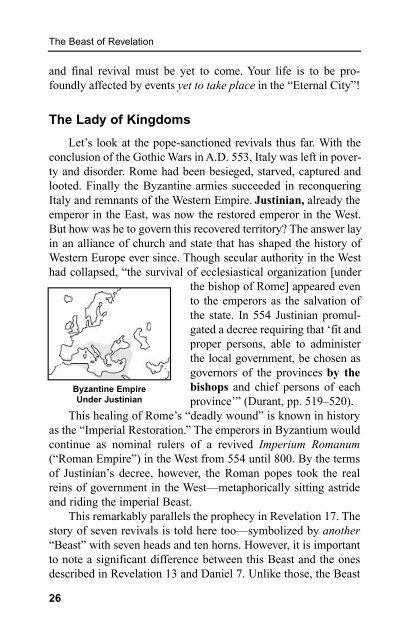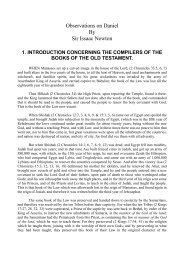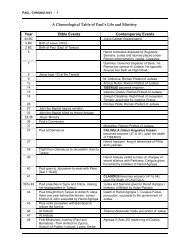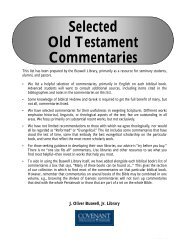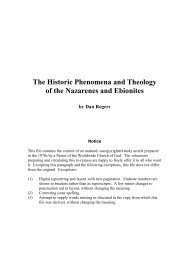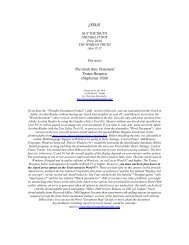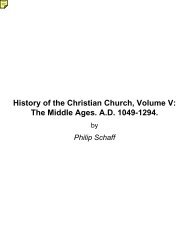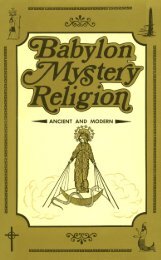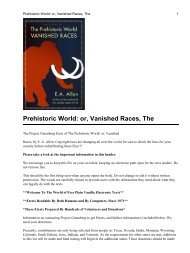Beast of Revelation.pdf - Friends of the Sabbath Australia
Beast of Revelation.pdf - Friends of the Sabbath Australia
Beast of Revelation.pdf - Friends of the Sabbath Australia
You also want an ePaper? Increase the reach of your titles
YUMPU automatically turns print PDFs into web optimized ePapers that Google loves.
The <strong>Beast</strong> <strong>of</strong> <strong>Revelation</strong><br />
and final revival must be yet to come. Your life is to be pr<strong>of</strong>oundly<br />
affected by events yet to take place in <strong>the</strong> “Eternal City”!<br />
The Lady <strong>of</strong> Kingdoms<br />
Let’s look at <strong>the</strong> pope-sanctioned revivals thus far. With <strong>the</strong><br />
conclusion <strong>of</strong> <strong>the</strong> Gothic Wars in A.D. 553, Italy was left in poverty<br />
and disorder. Rome had been besieged, starved, captured and<br />
looted. Finally <strong>the</strong> Byzantine armies succeeded in reconquering<br />
Italy and remnants <strong>of</strong> <strong>the</strong> Western Empire. Justinian, already <strong>the</strong><br />
emperor in <strong>the</strong> East, was now <strong>the</strong> restored emperor in <strong>the</strong> West.<br />
But how was he to govern this recovered territory? The answer lay<br />
in an alliance <strong>of</strong> church and state that has shaped <strong>the</strong> history <strong>of</strong><br />
Western Europe ever since. Though secular authority in <strong>the</strong> West<br />
had collapsed, “<strong>the</strong> survival <strong>of</strong> ecclesiastical organization [under<br />
<strong>the</strong> bishop <strong>of</strong> Rome] appeared even<br />
to <strong>the</strong> emperors as <strong>the</strong> salvation <strong>of</strong><br />
<strong>the</strong> state. In 554 Justinian promulgated<br />
a decree requiring that ‘fit and<br />
proper persons, able to administer<br />
<strong>the</strong> local government, be chosen as<br />
governors <strong>of</strong> <strong>the</strong> provinces by <strong>the</strong><br />
bishops and chief persons <strong>of</strong> each<br />
province’” (Durant, pp. 519–520).<br />
This healing <strong>of</strong> Rome’s “deadly wound” is known in history<br />
as <strong>the</strong> “Imperial Restoration.” The emperors in Byzantium would<br />
continue as nominal rulers <strong>of</strong> a revived Imperium Romanum<br />
(“Roman Empire”) in <strong>the</strong> West from 554 until 800. By <strong>the</strong> terms<br />
<strong>of</strong> Justinian’s decree, however, <strong>the</strong> Roman popes took <strong>the</strong> real<br />
reins <strong>of</strong> government in <strong>the</strong> West—metaphorically sitting astride<br />
and riding <strong>the</strong> imperial <strong>Beast</strong>.<br />
This remarkably parallels <strong>the</strong> prophecy in <strong>Revelation</strong> 17. The<br />
story <strong>of</strong> seven revivals is told here too—symbolized by ano<strong>the</strong>r<br />
“<strong>Beast</strong>” with seven heads and ten horns. However, it is important<br />
to note a significant difference between this <strong>Beast</strong> and <strong>the</strong> ones<br />
described in <strong>Revelation</strong> 13 and Daniel 7. Unlike those, <strong>the</strong> <strong>Beast</strong><br />
26<br />
Byzantine Empire<br />
Under Justinian


